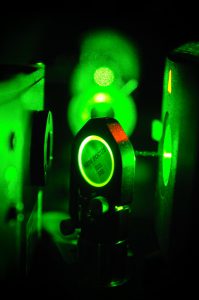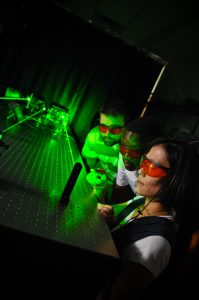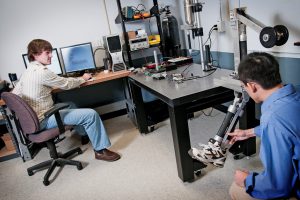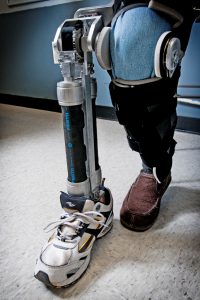By Mary Wymer and Whitney Taylor
How can medicine and engineering work together to enhance and improve our lives? Researchers throughout the world are combining these two very different fields through bioengineering.
A term first coined in the 1950s, bioengineering has since taken on many meanings in disciplines from biology to chemistry to medicine. While disciplines vary and applications, including molecular and pharmaceutical, abound, the core focus is designing and improving biological systems.
At The University of Alabama, numerous researchers embark on the challenge to bioengineer systems, specifically in breast cancer detection, cancer treatment options and robotic prosthetics. From chemical to electrical to mechanical engineering, faculty and students are working not only in campus labs, but alongside patients, to better solve their biological system challenges.

Imagine the discomfort of mammogram screenings one day ending as a UA electrical engineering professor investigates an alternative that would not only be safer, cheaper and pain-free, but also would provide instant results in the detection of breast cancer.
By studying the uses of terahertz radiation, Dr. Margaret Kim, assistant professor of electrical engineering, hopes to aid in the detection and prevention of breast cancer. Other than skin cancer, breast cancer is the most common cancer among women in the United States, and it is the second leading cause of cancer death in women, according to the American Cancer Society. In 2009, more than 192,000 women were expected to be diagnosed with new cases of invasive breast cancer, according to the society’s estimates.
Current imaging technologies for detecting breast tumors include mammography, which uses X-rays, and MRI, which uses strong magnetic fields. But, neither of these techniques is ideal. After a woman undergoes mammogram screenings, she must wait to learn whether a growth in the breast has been discovered. If a growth is discovered, a biopsy may be needed to determine if it is malignant. Mammograms often miss smaller tumors and can expose women – some of whom are already at high risk for developing cancer – to radiation. Conversely, MRI scans that detect alterations in tissue can produce false positives, leading to unnecessary biopsies.
By using terahertz radiation, or high frequency waves, Kim says doctors may be able to scan parts of the body for tumors and know instantaneously if a discovered growth was cancerous.
“The use of terahertz could possibly decrease the number of biopsies, and the process of waiting for lab results could also be eliminated because the results are immediate,” says Kim.
Women’s health safety could also be increased with terahertz usage. A mammogram produces ionized radiation which can be harmful to the body and possibly damage tissues, compared to terahertz radiation which is non-ionized and safer.

While the common use of MRI (magnetic resonance imaging) in cancer detection is rather safe, it’s too costly to incorporate as part of a routine exam. MRIs are used only when mammograms cannot resolve whether a tumor is benign or malignant. Kim says terahertz radiation is energetic enough to resolve features five times smaller than MRI and 50 times smaller than mammography. Data from the Centers for Disease Control and Prevention indicate screening to detect cancerous tumors, while they are still small, could prevent 16 percent of deaths associated with breast cancer in women over the age of 40. Terahertz radiation could be used for detection of cancers of the skin and other tissues.
“There are many difficulties to overcome before such a technology can be used routinely,” Kim says. “We are working to build a compact terahertz system that utilizes terahertz radiation for such a screening. Compact and user-friendly systems will dramatically increase the clinical use and reduce the cost and the barrier of access of the terahertz radiation in many areas.”
Receiving a research grant of $175,000 from the National Science Foundation Broadening Participation Research Initiation Grant, Kim is starting her research program by recruiting female engineering students to assist her in the study of terahertz radiation.
“I want to show women possible career options in engineering that would allow them to contribute to society,” Kim says. “This research could open doors for them as they would be researching technology that would help themselves and women everywhere.”
When Treatment is Worse than the Disease
Hearing a cancer diagnosis can be devastating. As patients begin coping with the reality of battling the disease, determining treatment plans can be equally as overwhelming and upsetting. As patients begin exploring chemotherapy options, many are surprised to discover these drugs not only kill the cancer but also destroy healthy cells.
In an effort to maximize the treatment possibilities and minimize the effects of chemotherapy, a team of UA researchers, led by Dr. Chris Brazel, associate professor of chemical engineering, investigate the use of magnetic hyperthermia and targeted drug delivery for cancer therapy. The goal of this technique is to successfully deliver the chemotherapy to the individual cancer cells, and activate the drug, by heat, through magnetism, without harming the surrounding healthy cells.
“The field of cancer therapy development holds great promise for improving patients’ lives,” says Amy Frees, a senior in chemical and biological engineering and an undergraduate research team member. “Developing a novel cancer therapy takes a lot of interdisciplinary cooperation, and I’ve been able to expand my view of engineering while developing useful research techniques.”
Throughout the past year, the research team has focused on developing temperature-sensitive polymers that host magnetic nanoparticles and deliver a drug in a burst when activated by magnetic heating. In particular, Frees’ project has shown that 5-fluorouracil, an anti-cancer drug, can be released with the drug burst triggered by heating the polymer above normal body temperature. This process combines hyperthermia and chemotherapy to be administered locally within the body. This complex research requires input from medical researchers, chemists, engineers and physicists, among others. The interdisciplinary nature of the project has brought about collaborations with faculty at UA and The University of Alabama at Birmingham and researchers in the United Kingdom and Bahrain.
In addition to Brazel’s work with magnetic hyperthermia, he recently spent a year with collaborators at Keele University’s Medical Center, as part of the Institute for Science and Technology in Medicine in Keele, Staffordshire, United Kingdom, via the Fulbright Scholars Program. While at Keele, Brazel researched advanced materials for magnetofection gene therapy, with particular emphasis on cystic fibrosis, and plans to continue an international collaboration to develop polymer scaffolds for delivery of calcium promoters for tissue engineering of bone.
Bionic Legs Exist Only in Science Fiction?

In the 1970s, “The Six Million Dollar Man” and “The Bionic Woman” were popular television shows that portrayed heroes with bionic implants performing seemingly unrealistic feats with unfathomable abilities. In the shows, the characters of Steve Austin and Jaime Sommers were considered medical miracles as their bionic limbs could not be distinguished from natural body parts. Hollywood and science fiction seemingly sought to convince the audience that technology was already able to build realistic looking and moving prosthetics.
Now, 40 years later, and back to reality: modern robotic prostheses are capable of sensing, computing and moving, but these prostheses do not have the inherent flexibility of human muscle. This can make the simulated limbs feel more like machines instead of extensions of the human body. With approximately 1.7 million people living with limb loss in the U.S., according to Amputee Coalition of America, development of artificial extremities that are realistic, flexible and powerful would be impactful. And that’s part of the growing field of biomechatronics – the fusing of mechanical devises with human muscles and skeleton.
Prostheses that match actual human muscle in appearance and functionality do not exist. With the ultimate objective to engineer a flexible, robotic actuator that functions and feels like human muscle, UA’s Bio-Robotics Lab is working under Dr. Xiangrong Shen’s leadership to design a prototype prosthetic with the end-user as the motivating factor.
Current leg prosthetics are energetically passive, meaning the artificial limb can only dissipate energy or store and reuse the energy within a gait cycle. The inability to deliver significant power impairs the artificial leg’s performance — especially during activities requiring positive power, like walking up stairs or running. Typically, the lack of energy is caused from two problems: one, the energy source, such as a battery, and the second is the actuator, or the motor and gear head, becoming too heavy for the prosthetic. When the limb is too heavy to function, the practicality for the user diminishes.

To address these issues, Shen’s team is working on a novel technology called chemo-fluidic artificial muscle, with the promising results of superior energy and power density. The three-phase research plan will first investigate the chemo-fluidic muscle actuators; secondly work on the self-contained flexible actuator, and finally work on the design to emulate musculo-skeletal structures.
Shen partners with representatives of a local business, Norris Limb and Brace, to better understand patient needs.
“When working with the various types of prosthetics, our number one priority is functionality for the patient’s lifestyle because fancy equipment can be useless if it doesn’t serve the patient’s needs,” says Mark Norris, owner of Norris Limb and Brace.
Shen’s team is working with an actuator that provides similar responses as a human muscle. Shen selected pneumatic artificial muscles because of their flexibility and high power density. The use of artificial muscle in self-powered robotic devices has been limited by the traditional pneumatic supplies of the gas tank, which are typically bulky and heavy. Overcoming the pneumatic supply limits and bulkiness of the system are major parts of the design challenge.
The breakthrough in the chemo-fluidic actuation alleviates some of the disadvantages of the pneumatic system. With a special type of liquid fuel, a monopropellant decomposes instantaneously upon contact with certain catalysts and generates a large amount of hot gas, which is used to drive pneumatic actuators directly. The monopropellant is nonflammable, highly controllable, and insensitive to shock.
This chemo-fluidic actuation system has been successfully demonstrated on cylinder-type systems, including a 21 degrees-of-freedom bionic arm. A chemo-fluidic artificial muscle leverages the high power density of artificial muscle and the high energy density of liquid fuel, and therefore is a very promising actuation choice for leg prostheses.
“Because of medical advances, we’re now seeing more amputee patients,” says Norris. “These prosthetic research areas are extremely important as the number of people needing various types of limb assistance is increasing.”
As engineering faculty and students strive for advances in these various medical challenges, the overall goal is the public’s betterment. At the core, engineers are problem solvers, and these research projects have tapped into the soul of engineers – how to find the answers that best meet the needs of society.
Contact
Katie McInnish or Linda Hill, UA Media Relations, 205/348-8325, lhill@ur.ua.edu